J2 League
| Founded | 1999 (1999) |
|---|---|
| Country | Japan |
| Confederation | AFC (Asia) |
| Number of teams | 22 |
| Level on pyramid | 2 |
Promotion to | J1 League |
Relegation to | J3 League |
| Domestic cup(s) | Emperor's Cup |
| Current champions | Shonan Bellmare (2017) |
| Most championships | Consadole Sapporo (3 titles) |
| TV partners | DAZN |
| Website | Official Website |
Former logo
The J2 League (J2リーグ, J2 Rīgu) is the second division of the Japan Professional Football League (日本プロサッカーリーグ, Nippon Puro Sakkā Rīgu) and the second-tier professional association football league in Japan. It (along with the rest of the J.League) is currently sponsored by Meiji Yasuda Life and it is thus officially known as the Meiji Yasuda J2 League. Until the 2014 season it was named the J.League Division 2. Currently, the J2 League is the second level of the Japanese association football league system. The top tier is represented by the J1 League.
Second-tier club football has existed in Japan since 1972; however, it was only professionalized during the 1999 season with ten clubs. The league took one relegating club from the top division and nine clubs from the second-tier semi-professional former Japan Football League to create the J2 League. The remaining seven clubs in the Japan Football League, the newly formed Yokohama FC, and one promoting club from the Regional Leagues, formed the nine-club Japan Football League, then the third tier of Japanese football. The third tier is now represented by the J3 League.
Contents
1 History
1.1 Phases of Japanese second-tier association football
1.1.1 Amateur era (until 1999)
1.1.2 Professionalization era (1999–2004)
1.1.3 Early expansion era (2004–2009)
1.1.4 Introduction of double round-robin (2010–2011)
1.1.5 End of expansion and J2 Playoffs (2012–present)
1.1.6 Future plans (2013–present)
1.2 Timeline
2 Stance in the Japanese football pyramid
3 2017 season
3.1 League formats
3.2 Participating clubs (2017)
3.3 Stadiums (2017)
3.4 Former clubs
4 Championship and promotion history
4.1 Most successful clubs
4.2 Promotion playoff results
5 Relegation history
6 Other tournaments
7 Players and managers
7.1 Managers
7.2 Top scorers
8 See also
9 References
10 External links
History
- For history of Japanese club football before the inception of the professional league in 1993, see Japan Soccer League.
- For detailed history of J1 League, see J1 League#History.
Phases of Japanese second-tier association football
Amateur era (until 1999)
A national second tier of Japanese association football was first established in 1972, when the Japan Soccer League formed a Second Division. Among the founding 10 clubs, 5 later competed in the J.League: Toyota Motors (inaugural champion), Yomiuri, Fujitsu, Kyoto Shiko Club and Kofu Club.
The new division consisted of 10 clubs, like the First Division, and initially required both the champion and runner-up teams to play off a Promotion/Relegation series of test matches against the top flight's bottom clubs. The requirement was abolished for the champions in 1980, and for the runners-up in 1984.
Prior to 1977, the way for clubs to gain access to the Second Division was by making the finals of the All Japan Senior Football Championship and then playing off in their own Promotion/Relegation series against the second tier's bottom clubs. After 1977, the new Regional Football League Competition served as provider of aspiring League clubs. In 1985, the Second Division increased to 12 clubs and in 1986, the number reached 16. Until 1989, the table was divided into East and West groups, depending on geographical location; after that year and until 1992 the table was unified.
In 1992, following the formation of the J.League, the JSL Second Division was renamed the (former) Japan Football League. The league was divided into two hierarchical, unequal divisions of 10 clubs each. In 1994, the JFL was again reunified into a single division. As the J.League expanded in numbers, the need for another second tier with promotion and relegation arose, as the number of clubs which wanted to become professional increased (particularly in the case of Shonan Bellmare, Kashiwa Reysol, Cerezo Osaka and Júbilo Iwata, who had been JSL First Division champions but had not been chosen for the inaugural J.League season).
Professionalization era (1999–2004)
The infrastructure of the league was heavily changed in 1999. The league acquired nine clubs from the semi-professional JFL and one club from J.League to create a two-division system, both being the professional leagues. The top flight became the J.League Division 1 (J1) with 16 clubs while J.League Division 2 (J2) was launched with ten clubs in 1999. The second-tier (former) Japan Football League became the third-tier Japan Football League at that time.
The criteria for becoming a J2 club were not as strict as those for the top division. This allowed smaller cities and towns to maintain a club successfully without investing as much as clubs in J1. In fact, clubs like Mito HollyHock only draw an average of 3,000 fans a game and receive minimal sponsorship, yet still field fairly competitive teams in J2.
Clubs in J2 took time to build their teams for J1 promotion, as they also tried to gradually improve their youth systems, their home stadium, their financial status, and their relationship with their hometown. Clubs such as Oita Trinita, Albirex Niigata, Kawasaki Frontale, and Ventforet Kofu accomplished this successfully. All these clubs originally started as J2 in 1999 and were comparatively small, but they eventually earned J1 promotion, in 2002, 2003, 2004, and 2005 respectively. Even though Kofu and Oita were later relegated back to Division 2, they are well-established association football clubs, managing to average 10,000 fans per game.
The league also began to follow European game formats, as time went on. In the first three seasons (1999–2001), games were played with extra time for regular league matches if there was no winner at end of the regulation. The extra time was abolished in 2002, and the league adopted the standard 3-1-0 points system.
Early expansion era (2004–2009)
Two Japan Football League clubs, Mito HollyHock and Yokohama FC joined the J2 League in the 2000 and 2001 seasons. Mito initially tried in the 1999 season, but failed, having better luck the following year. On the other hand, Yokohama FC was formed by the fans of Yokohama Flügels, who went defunct after the merger with Yokohama F. Marinos on 1 January 1999. In essence, these two clubs could and should have joined the league in the inaugural year with the original ten clubs, and it was inevitable that they were eventually accepted by the league.
However, besides these two clubs, it seemed that there was no interest from the lower-level clubs; the second division did not see any further expansion for a few seasons. In 2004, however, two clubs showed interest as Thespa Kusatsu and Tokushima Vortis were accepted to the league. Two years later, in the 2006 season, Ehime FC followed in their footsteps. It turned out that many clubs were aiming for membership at the professional level. However, in the early 2000s, these clubs were still in the regional leagues, and it took them three to four years to even eye professionalism.
Clearly, the concept of second-tier professional association football – the fact that clubs can compete at the professional level with low budgets, was something that attracted many amateur clubs across the nation of Japan. At the beginning of the 2006 season, the league took a survey to determine the number of non-league clubs interested in joining the professional league. The results showed that about 40 to 60 clubs in Japan had plans to professionalize over the next 30 years. From the league's perspective, the J.League 'Hundred Year Vision' from the late '90s has been moving in a positive direction.
In light of this, league management formed a committee and looked at two practical options for further expansion – either expand the second division or form a third division. In other words, the league had a choice between letting the non-league clubs achieve the J2 standard, or forming a third division with non-league clubs, where these clubs can prepare for J2. After conducting several case studies, the committee made a professional assessment that it was in the best interest of the league to expand the J2 to 22 clubs rather than form a third division. Several reasons led the committee to this decision:
- The Japan Football League, then the third tier in the Japanese football league system, was already serving the purpose of preparing the non-league clubs.
- At the time, most non-league clubs interested in professionalism were still in the regional or prefectural leagues, two to four levels below J2.
- Twenty-two clubs is the perfect number for the J2 league, as it allows enough home games for annual revenue, while keeping the competition a fair double-round-robin format.
- Most European leagues have similar association football pyramids, where there are more clubs in 2nd and 3rd-tier leagues than in the top flight.
The committee also reintroduced Associate Membership System in the 2006 season. This allowed the committee to identify interested non-league clubs and provide necessary resources to them. The membership was exclusively given to non-league clubs that had intentions of joining the J.League, while meeting most of the criteria for J2 promotion. Several clubs in the Japan Football League and Regional Leagues have applied for and received membership. Associate members finishing in the top 4 of the JFL were promoted to J2. Following the promotion of Ehime F.C., six more clubs joined J2 League through this system.
As the number of clubs increased, the league format changed from a quadruple round-robin to a triple round-robin format. This was adopted during the 2008 season with 15 clubs and the 2009 season with 18 clubs. In 2009, the J2 league also saw an increase in promotion slots to three, to accommodate the eighteen-club league. As a result, the Promotion/Relegation Series, which allowed the third-place J2 clubs to fight for J1 slots for the following season, was abolished, after its introduction in the 2004 season.
Introduction of double round-robin (2010–2011)
When the league reached 19 clubs in the 2010 season, the J2 League adopted the double round-robin format. The league continued to expand to 22 clubs, and until then there was no relegation to the Japan Football League. In the next few seasons, the maximum number of clubs that could be promoted to J2 was decided by taking the difference of twenty-two minus the number of clubs in J2.
End of expansion and J2 Playoffs (2012–present)
When the league reached 22 clubs, two new regulations were introduced. Only the top two clubs earn automatic promotion, while clubs from 3rd to 6th entered playoffs for the final third promotion slot, as in the Football League Championship, Serie B, or Segunda División.[citation needed]
However, the rules will be heavily slanted to favor those with higher league placement:
- The team third in the standings will face the sixth place team, and the fourth place team will face the fifth, as in the European leagues; however, unlike these leagues, the round will be only one match, at the home side of the higher placed team.
- The winners of the two matches meet at the home side of the higher placed team, or potentially at a neutral venue (likely Tokyo National Stadium). The winner of this match is promoted to J1.
- In all matches, in case of a draw after regulation time, the team that ended the season with the higher placement in the league table will be considered the winner, so there will be no extra time and/or penalty shootout.
- If teams ineligible for promotion finished above sixth, they will not be allowed to participate in the playoffs. Instead, the highest ranked team(s) will receive byes.
Also starting in 2012, at most two clubs can be relegated to the lower tier (for 2012 season only, Japan Football League; from 2013, J3 League), depending on how that league finished.
Future plans (2013–present)
Starting in 2013, a club licensing system was implemented. Clubs failing to fulfill this licensing requirement can be relegated to the third tier, regardless of their league position. The third-tier league, J3 League, was established in 2014, targeting teams having ambitions to reach the J.League. The structure of J2 is likely to remain stable.
Timeline
| Year | Important Events | # J2 Clubs | Prom. Slots | Rel. Slots |
|---|---|---|---|---|
| 1999 |
| 10 | 2 | 0 |
| 2000 |
| 11 | 2 | 0 |
| 2001 |
| 12 | 2 | 0 |
| 2002 |
| 12 | 2 | 0 |
| 2003 | 12 | 2 | 0 | |
| 2004 |
| 12 | 2.5 | 0 |
| 2005 |
| 12 | 2.5 | 0 |
| 2006 |
| 13 | 2.5 | 0 |
| 2007 | 13 | 2.5 | 0 | |
| 2008 |
| 15 | 2.5 | 0 |
| 2009 |
| 18 | 3 | 0 |
| 2010 |
| 19 | 3 | 0 |
| 2011 |
| 20 | 3 | 0 |
| 2012 |
| 22 | 3 | 1 |
| 2013 |
| 22 | 3 | 0.5 |
| 2014 |
| 22 | 3 | 1.5 |
| 2015 |
| 22 | 3 | 1.5 |
| 2016 |
| 22 | 3 | 1.5 |
| 2017 |
| 22 | 3 | 2 |
Stance in the Japanese football pyramid
Since the inception of the second division in 1999, promotion and relegation follow a pattern similar to European leagues, where the two bottom clubs of J1 and the top two clubs of J2 are guaranteed to move. From the 2004 to the 2008 season, the third-place J2 club entered a Promotion/Relegation Series against the sixteenth-place J1 club, with the winner playing in the top flight in the following year. Starting after the 2009 season, the top three J2 clubs received J1 promotion by default, replacing three relegated bottom J1 clubs. However, promotion or the right to play the now-defunct pro/rele series relied on the J2 clubs meeting the requirements for J1 franchise status set by the league. This was not a hindrance, in fact, as no club has been denied promotion due to not meeting the J1 criteria.
The J3 League is currently the third level in the association football system, supplanting the Japan Football League (JFL) which is now one step lower in the system. Being a professional league, the J.League allows only certain clubs from J3 to be promoted. In 2000, 2001, and 2006 the JFL league champion was promoted to J2; in 2005 two teams were promoted. From 2007, the league requires J.League Associate Membership and at least a fourth-place finish in JFL (J3 from 2013) to be promoted to J2. Currently, there are two relegations from J2 to J3. Since 1999, a total of sixteen clubs from JFL (later J3) have been promoted to J2, two of which were expanded into J1. Currently, J1 has 18 clubs and J2 has 22 clubs. Division two expanded to 22 clubs from 20; regular promotion and relegation is in place.
Since its inception in 1999, the format of J2 has been consistent. Clubs played a quadruple round-robin (two home and away) format during the 1999 to 2007 seasons. To accommodate the ongoing expansion process, a triple round-robin format was implemented during the 2008 and 2009 seasons. Until the 2001 season, the clubs played extra time if they were tied after regulation and the clubs received three points for a regulation win, two points for an extra time win, one point for a draw, and no points for a loss (there were no penalties). However, starting in 2002, the league abolished extra time and set the points system to the standard three-one-nil system.
The number of clubs reached 19 in 2010, and the league format was changed to double round-robin. The number increased to 20 in 2011 and to 22 in 2012, where it has remained since then.
2017 season
League formats
Twenty-two clubs will play in double round-robin format, a total of 42 games each. A club receives three points for a win, one point for a tie, and no points for a loss. The clubs are ranked by points, and tie breakers are, in the following order:
- Goal difference
- Goals scored
- Head-to-head results
- Disciplinary points
A draw would be conducted, if necessary. However, if two clubs are tied at first place, both clubs will be declared champions. Two top clubs will be directly promoted to J1, and the third promotion spot will be decided in the playoff series among clubs placed third to sixth. Note that in order to participate in the playoffs a club must possess a J1 license; if one or more clubs fail to do so, they will not be allowed in the playoffs and they will not be replaced by other clubs.
The relegation to the lower tier J3 League will depend on the number and final standings of promotion-eligible clubs that possess a J2 license. Up to two clubs can be exchanged between two leagues, with direct promotion/relegation between the two bottom-place J2 teams (21st and 22nd) and top two J3 teams (champion and runner-up). If one or both J3 promotion candidates fail to obtain a J2 license, they will not be allowed to promote and J2 relegation spots will be cut accordingly.
- Prize money
- First place: 20,000,000 yen
- Second place: 10,000,000 yen
- Third place: 5,000,000 yen
Participating clubs (2017)
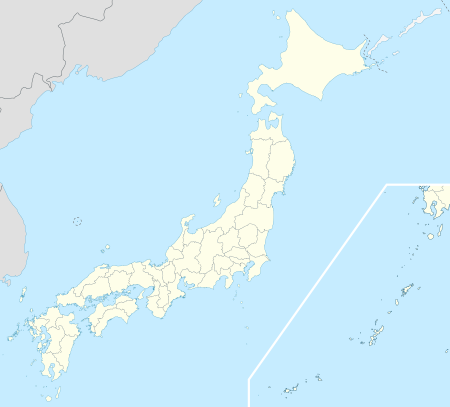
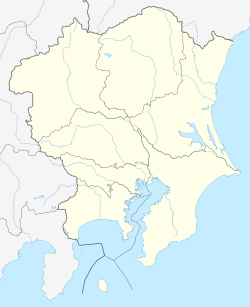
| Club name | Year joined | Seasons in J2 | Based in | First season in D2 | Seasons in D2 | Current spell in D2 | Last spell in top flight |
|---|---|---|---|---|---|---|---|
Avispa Fukuoka | 1996 (J) | 13 | Fukuoka, Fukuoka | 1991/92 | 17 | 2017– | 2016 |
Shonan Bellmare | 1994 (J) | 14 | Western cities/towns in Kanagawa | 1990/91 | 18 | 2017– | 2015–2016 |
Ehime FC | 2006 | 12 | All cities/towns in Ehime | 2006 | 12 | 2006– | – |
Fagiano Okayama | 2009 | 9 | All cities/towns in Okayama | 2009 | 9 | 2009– | – |
FC Gifu | 2008 | 10 | All cities/towns in Gifu | 2008 | 10 | 2008– | – |
Nagoya Grampus | 1993 (J) | 1 | All cities/towns in Aichi | 1972 | 13 | 2017– | 1990–2016 |
Mito HollyHock | 2000 | 18 | Mito, Ibaraki | 1997 | 20 | 2000– | – |
JEF United Chiba | 1993 (J) | 8 | Chiba & Ichihara, Chiba | 2010 | 8 | 2010– | 1965–2009 |
Kamatamare Sanuki | 2014 | 4 | All cities/towns in Kagawa | 2014 | 4 | 2014– | – |
Montedio Yamagata | 1999 | 15 | All cities/towns in Yamagata | 1994 | 20 | 2016– | 2015 |
Renofa Yamaguchi | 2015 (J3) | 2 | All cities/towns in Yamaguchi | 2016 | 2 | 2016– | – |
Roasso Kumamoto | 2008 | 10 | Kumamoto, Kumamoto | 2008 | 10 | 2008– | – |
Kyoto Sanga | 1996 (J) | 11 | Southwestern cities in Kyoto | 1972 | 24 | 2010– | 2008–2010 |
Thespa Kusatsu | 2005 | 13 | All cities/towns in Gunma | 2005 | 13 | 2005– | – |
Oita Trinita | 1999 | 11 | Ōita, Ōita | 1996 | 14 | 2017– | 2013 |
Tokyo Verdy | 1993 (J) | 11 | Tokyo | 1972 | 17 | 2009– | 2008 |
Yokohama FC | 2001 | 16 | Yokohama, Kanagawa | 2001 | 16 | 2008– | 2007 |
V-Varen Nagasaki | 2013 | 5 | All cities/towns in Nagasaki | 2013 | 5 | 2013– | – |
Tokushima Vortis | 2005 | 11 | All cities/towns in Tokushima | 1990/91 | 19 | 2015– | 2014 |
Matsumoto Yamaga | 2012 | 5 | Central cities/towns in Nagano | 2012 | 5 | 2016– | 2015 |
Machida Zelvia | 2012 | 2 | Machida, Tokyo | 2012 | 3 | 2016– | – |
Zweigen Kanazawa | 2014 (J3) | 3 | Kanazawa, Ishikawa | 2015 | 3 | 2015– | – |
- Gray background denotes club was most recently relegated/demoted from Division 1.
- Pink background denotes club was most recently promoted from J3 League.
- "Year joined" is the year the club joined the J.League (Division 2 unless otherwise indicated).
- "First season in D2," "Seasons in D2," and "Last spell in D2" take into account all past incarnations of second-tier football: the second division of the Japan Soccer League and the former Japan Football League.
- "Last spell in top flight" includes seasons in the old Japan Soccer League First Division.
Stadiums (2017)
Primary venues used in the J2 League:
Avispa Fukuoka | Shonan Bellmare | Ehime F.C. | Fagiano Okayama | Nagoya Grampus | Matsumoto Yamaga FC |
|---|---|---|---|---|---|
Level-5 Stadium | Shonan BMW Stadium Hiratsuka | Ningineer Stadium | Kanko Stadium | Toyota Stadium | Matsumotodaira Football Stadium |
| Capacity: 22,563 | Capacity: 18,500 | Capacity: 20,000 | Capacity: 20,000 | Capacity: 45,000 | Capacity: 20,396 |
 |  |  | 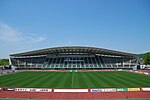 | 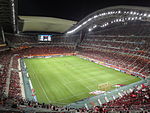 | 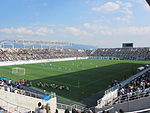 |
F.C. Gifu | Oita Trinita | JEF United Ichihara Chiba | Montedio Yamagata | Kamatamare Sanuki | Kyoto Sanga F.C. |
Gifu Nagaragawa Stadium | Ōita Bank Dome | Fukuda Denshi Arena | ND Soft Stadium | Kagawa Marugame Stadium | Nishikyogoku Athletic Stadium |
| Capacity: 20,000 | Capacity: 40,000 | Capacity: 18,500 | Capacity: 20,315 | Capacity: 30,099 | Capacity: 20,588 |
 |  |  |  |  | |
Mito Hollyhock | Roasso Kumamoto | Thespakusatsu Gunma | Renofa Yamaguchi FC | FC Machida Zelvia | Tokyo Verdy |
K's denki Stadium Mito | Umakana Yokana Stadium | Shoda Shoyu Stadium Gunma | Yamaguchi Ishin Park Stadium | Machida Athletic Stadium | Ajinomoto Stadium |
| Capacity: 12,000 | Capacity: 32,000 | Capacity: 15,253 | Capacity: 20,000 | Capacity: 10,600 | Capacity: 49,970 |
 | 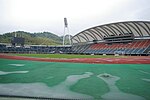 | 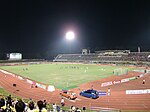 | 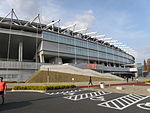 | 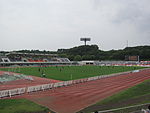 |  |
Tokushima Vortis | V-Varen Nagasaki | Yokohama FC | Zweigen Kanazawa | ||
Pocarisweat Stadium | Nagasaki Athletic Stadium | Nippatsu Mitsuzawa Stadium | Ishikawa Kanazawa Stadium | ||
| Capacity: 20,441 | Capacity: 20,246 | Capacity: 15,454 | Capacity: 20,000 | ||
 |  | 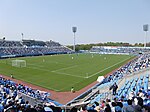 |  |
Former clubs
| Club | Year joined | Seasons in J2 | Based in | First season in D2 | Seasons in D2 | Last spell in D2 | Current league |
|---|---|---|---|---|---|---|---|
Albirex Niigata | 1999 | 5 | Niigata & Seiro, Niigata | 1998 | 6 | 1998–2003 | J1 |
Omiya Ardija | 1999 | 7 | Saitama, Saitama | 1987/88 | 17 | 2015 | J1 |
Cerezo Osaka | 1995 (J) | 6 | Osaka and Sakai, Osaka | 1991/92 | 10 | 2015–2016 | J1 |
Consadole Sapporo | 1998 (J) | 14 | All cities/towns in Hokkaido | 1978 | 31 | 2013–2016 | J1 |
Kawasaki Frontale | 1999 | 5 | Kawasaki, Kanagawa | 1972 | 25 | 2001–2004 | J1 |
Gainare Tottori | 2011 | 3 | All cities/towns in Tottori | 2011 | 3 | 2011–2013 | J3 |
Gamba Osaka | 1993 (J) | 1 | Suita, Osaka | 1984 | 4 | 2013 | J1 |
Giravanz Kitakyushu | 2010 | 7 | Kitakyushu, Fukuoka | 2010 | 7 | 2010–2016 | J3 |
Júbilo Iwata | 1994 (J) | 2 | Iwata, Shizuoka | 1979 | 6 | 2014–2015 | J1 |
Kataller Toyama | 2009 | 6 | All cities/towns in Toyama | 2009 | 6 | 2009–2014 | J3 |
Kashiwa Reysol | 1995 (J) | 2 | Kashiwa, Chiba | 1987/88 | 8 | 2010 | J1 |
Urawa Red Diamonds | 1993 (J) | 1 | Saitama, Saitama | 1989/90 | 2 | 2000 | J1 |
Shimizu S-Pulse | 1993 (J) | 1 | Shizuoka, Shizuoka | 2016 | 1 | 2016 | J1 |
Sagan Tosu | 1999 | 13 | Tosu, Saga | 1997 | 15 | 1997–2011 | J1 |
Sanfrecce Hiroshima | 1993 (J) | 2 | Hiroshima, Hiroshima | 1984 | 7 | 2008 | J1 |
FC Tokyo | 1999 | 2 | Tokyo | 1991/92 | 10 | 2011 | J1 |
Tochigi SC | 2009 | 7 | Utsunomiya, Tochigi | 2009 | 7 | 2009–2015 | J3 |
Vegalta Sendai | 1999 | 9 | Sendai, Miyagi | 1995 | 13 | 2004–2009 | J1 |
Ventforet Kofu | 1999 | 11 | All cities/towns in Yamanashi | 1972 | 36 | 2012 | J1 |
Vissel Kobe | 1997 (J) | 2 | Kobe, Hyōgo | 1986/87 | 11 | 2013 | J1 |
- Pink background denotes clubs that were most recently promoted to J1 League.
- Gray background denotes club that was most recently relegated to J3 League.
- "Year joined" is the year the club joined the J.League (Division 2 unless otherwise indicated).
- "First season in D2," "Seasons in D2," and "Last Spell in D2" take into account all past incarnations of second-tier football: the second division of the Japan Soccer League and the former Japan Football League
Championship and promotion history
The top two clubs receive promotion. From the 2004 season to the 2008 season, the 3rd place club played the Promotion/Relegation Series against the 16th-place club in J1. From the 2009 season to the 2011 season, the 3rd place club was promoted by default. Beginning in the 2012 season, the third promotion place is determined by a playoff between the 3rd to 6th actual places.
| Year | Champion | Runner-up | 3rd place | Playoff winner |
|---|---|---|---|---|
1999 | Kawasaki Frontale | FC Tokyo | Oita Trinita | N/A |
2000 | Consadole Sapporo | Urawa Red Diamonds | Oita Trinita | |
2001 | Kyoto Purple Sanga | Vegalta Sendai | Montedio Yamagata | |
2002 | Oita Trinita | Cerezo Osaka | Albirex Niigata | |
2003 | Albirex Niigata | Sanfrecce Hiroshima | Kawasaki Frontale | |
2004 | Kawasaki Frontale | Omiya Ardija | Avispa Fukuoka † | |
2005 | Kyoto Purple Sanga | Avispa Fukuoka | Ventforet Kofu ‡ | |
2006 | Yokohama FC | Kashiwa Reysol | Vissel Kobe ‡ | |
2007 | Consadole Sapporo | Tokyo Verdy 1969 | Kyoto Sanga ‡ | |
2008 | Sanfrecce Hiroshima | Montedio Yamagata | Vegalta Sendai† | |
2009 | Vegalta Sendai | Cerezo Osaka | Shonan Bellmare | |
2010 | Kashiwa Reysol | Ventforet Kofu | Avispa Fukuoka | |
2011 | FC Tokyo | Sagan Tosu | Consadole Sapporo | |
2012 | Ventforet Kofu | Shonan Bellmare | Kyoto Sanga | Oita Trinita (6th) |
2013 | Gamba Osaka | Vissel Kobe | Kyoto Sanga | Tokushima Vortis (4th) |
2014 | Shonan Bellmare | Matsumoto Yamaga | JEF United Chiba | Montedio Yamagata (6th) |
2015 | Omiya Ardija | Júbilo Iwata | Avispa Fukuoka (3rd)‡ | |
2016 | Consadole Sapporo | Shimizu S-Pulse | Matsumoto Yamaga | Cerezo Osaka (4th)‡ |
2017 | Shonan Bellmare | V-Varen Nagasaki | Nagoya Grampus (3rd)‡ | |
* Bold designates the promoted club
† Lost the Promotion/Relegation Series
‡ Won the Promotion/Relegation Series and got promoted
Most successful clubs
Clubs in bold compete in J2 as of the 2017 season.
| Club | Winners | Runners-up | Promotions | Winning seasons | Runners-up seasons | Promotion seasons |
|---|---|---|---|---|---|---|
Consadole Sapporo | 3 | 0 | 4 | 2000, 2007, 2016 | 2000, 2007, 2011, 2016 | |
Shonan Bellmare | 2 | 1 | 4 | 2014, 2017 | 2012 | 2009, 2012, 2014, 2017 |
Kyoto Sanga | 2 | 0 | 3 | 2001, 2005 | 2001, 2005, 2007 | |
Kawasaki Frontale | 2 | 0 | 2 | 1999, 2004 | 1999, 2004 | |
Ventforet Kofu | 1 | 1 | 3 | 2012 | 2010 | 2005, 2010, 2012 |
Sanfrecce Hiroshima | 1 | 1 | 2 | 2008 | 2003 | 2003, 2008 |
Vegalta Sendai | 1 | 1 | 2 | 2009 | 2001 | 2001, 2009 |
Kashiwa Reysol | 1 | 1 | 2 | 2010 | 2006 | 2006, 2010 |
FC Tokyo | 1 | 1 | 2 | 2011 | 1999 | 1999, 2011 |
Omiya Ardija | 1 | 1 | 2 | 2015 | 2004 | 2004, 2015 |
Oita Trinita | 1 | 0 | 2 | 2002 | 2002, 2012 | |
Albirex Niigata | 1 | 0 | 1 | 2003 | 2003 | |
Yokohama FC | 1 | 0 | 1 | 2006 | 2006 | |
Gamba Osaka | 1 | 0 | 1 | 2013 | 2013 | |
Cerezo Osaka | 0 | 2 | 3 | 2002, 2009 | 2002, 2009, 2016 | |
Avispa Fukuoka | 0 | 1 | 3 | 2005 | 2005, 2010, 2015 | |
Vissel Kobe | 0 | 1 | 2 | 2013 | 2006, 2013 | |
Montedio Yamagata | 0 | 1 | 2 | 2008 | 2008, 2014 | |
Urawa Red Diamonds | 0 | 1 | 1 | 2000 | 2000 | |
Tokyo Verdy | 0 | 1 | 1 | 2007 | 2007 | |
Sagan Tosu | 0 | 1 | 1 | 2011 | 2011 | |
Matsumoto Yamaga | 0 | 1 | 1 | 2014 | 2014 | |
Júbilo Iwata | 0 | 1 | 1 | 2015 | 2015 | |
Shimizu S-Pulse | 0 | 1 | 1 | 2016 | 2016 | |
V-Varen Nagasaki | 0 | 1 | 1 | 2017 | 2017 | |
Tokushima Vortis | 0 | 0 | 1 | 2013 | ||
Nagoya Grampus | 0 | 0 | 1 | 2017 |
Promotion playoff results
| Season | First semi-final (3rd vs 6th) | Second semi-final (4th vs 5th) | Final |
|---|---|---|---|
2012 | Kyoto Sanga 0–4 Oita Trinita | Yokohama FC 0–4 JEF United Chiba | Oita Trinita 1–0 JEF United Chiba |
2013 | Kyoto Sanga 0–0 V-Varen Nagasaki | Tokushima Vortis 1–1 JEF United Chiba | Kyoto Sanga 0–2 Tokushima Vortis |
2014 | Not held | Júbilo Iwata 1–2 Montedio Yamagata | JEF United Chiba 0–1 Montedio Yamagata |
2015 | Avispa Fukuoka 1–0 V-Varen Nagasaki | Cerezo Osaka 0–0 Ehime FC | Avispa Fukuoka 1–1 Cerezo Osaka |
2016 | Matsumoto Yamaga 1–2 Fagiano Okayama | Cerezo Osaka 1–1 Kyoto Sanga | Cerezo Osaka 1–0 Fagiano Okayama |
2017 | Nagoya Grampus 4–2 JEF United Chiba | Avispa Fukuoka 1–0 Tokyo Verdy | Nagoya Grampus 0–0 Avispa Fukuoka |
- Results
| Club | Participated | Winners | Runners-up | Seasons participated | Winning seasons | Runner-up seasons |
|---|---|---|---|---|---|---|
Cerezo Osaka | 2 | 1 | 1 | 2015, 2016 | 2016 | 2015 |
Avispa Fukuoka | 2 | 1 | 1 | 2015, 2017 | 2015 | 2017 |
Montedio Yamagata | 2 | 1 | 0 | 2014, 2016 | 2014 | |
Oita Trinita | 1 | 1 | 0 | 2012 | 2012 | |
Tokushima Vortis | 1 | 1 | 0 | 2013 | 2013 | |
Nagoya Grampus | 1 | 1 | 0 | 2017 | 2017 | |
JEF United Chiba | 4 | 0 | 2 | 2012, 2013, 2014, 2017 | 2012, 2014 | |
Kyoto Sanga | 3 | 0 | 1 | 2012, 2013, 2016 | 2013 | |
Yokohama FC | 1 | 0 | 0 | 2012 | ||
V-Varen Nagasaki | 1 | 0 | 0 | 2013 | ||
Júbilo Iwata | 1 | 0 | 0 | 2014 | ||
Ehime FC | 1 | 0 | 0 | 2015 | ||
Fagiano Okayama | 1 | 0 | 0 | 2016 | ||
Tokyo Verdy | 1 | 0 | 0 | 2017 |
Relegation history
Upon the formation of the second division, the league had not implemented any relegation mechanism between J2 and the (formerly) third-tier Japan Football League, and the exchange between divisions worked one-way only. After years of gradual expansion the division has reached its planned capacity of 22 teams, therefore allowing J.League to start relegating bottom-place teams to JFL. Machida Zelvia set the unhappy milestone in 2012, becoming the very first team to be relegated from J2 (and the only team ever to be relegated to JFL). Next year the professional J3 League was formed, making relegation between second and third tiers a permanent establishment.
The rules for exchange between J2 and J3 are the following since 2017: the 21st and 22nd-place J2 teams are relegated immediately and are replaced by the J3 champion and runner-up.[2] If one or both J3 contenders do not possess J2 licenses, they are not allowed to be promoted, and the relegation spots for J2 sides are reduced accordingly.
| Year | 21st place | 22nd place |
|---|---|---|
2012 | FC Gifu | Machida Zelvia |
2013 | FC Gifu | Gainare Tottori‡ |
2014 | Kamatamare Sanuki† | Kataller Toyama |
2015 | Oita Trinita‡ | Tochigi SC |
2016 | Zweigen Kanazawa† | Giravanz Kitakyushu |
2017 | Roasso Kumamoto | Thespakusatsu Gunma |
* Bold designates relegated clubs
† Won the playoff against JFL or J3 team
‡ Lost the playoff series to JFL or J3 team and was relegated
Other tournaments
- Domestic tournaments
Emperor's Cup (1921–)
XEROX Super Cup (1994–)
- Defunct tournament
Promotion/Relegation Series (2004–2008, 2014–)
Players and managers
Managers
- List of J.League managers
Top scorers
| Year | Player | Nationality | Squad | Goals |
|---|---|---|---|---|
1999 | Takuya Jinno | Oita Trinita | 19 | |
2000 | Emerson Sheik | Consadole Sapporo | 31 | |
2001 | Marcos | Vegalta Sendai | 34 | |
2002 | Marx | Albirex Niigata | 19 | |
2003 | 32 | |||
2004 | Juninho | Kawasaki Frontale | 37 | |
2005 | Paulinho | Kyoto Purple Sanga | 22 | |
2006 | Borges | Vegalta Sendai | 26 | |
2007 | Hulk | Tokyo Verdy | 37 | |
2008 | Hisato Sato | Sanfrecce Hiroshima | 28 | |
2009 | Shinji Kagawa | Cerezo Osaka | 27 | |
2010 | Mike Havenaar | Ventforet Kofu | 20 | |
2011 | Yohei Toyoda | Sagan Tosu | 23 | |
2012 | Davi | Ventforet Kofu | 32 | |
2013 | Kempes | JEF United Chiba | 22 | |
2014 | Masashi Oguro | Kyoto Sanga | 26 | |
2015 | Jay Bothroyd | Júbilo Iwata | 20 | |
2016 | Jong Tae-se | Shimizu S-Pulse | 26 | |
2017 | Ibba Laajab | Yokohama FC | 21 |
See also
- J.League
- J.League records
- J.League contracts
- J.League awards
- J.League designated special players
- J.League MVP of the month
- J.League historical goals
- Japan derbies
References
^ Orlowitz, Dan (13 December 2011). "Japan's J-League officially admits Matsumoto Yamaga and Machida Zelvia into 2012 season". Goal. Archived from the original on 24 September 2015. Retrieved 11 September 2015..mw-parser-output cite.citation{font-style:inherit}.mw-parser-output q{quotes:"""""""'""'"}.mw-parser-output code.cs1-code{color:inherit;background:inherit;border:inherit;padding:inherit}.mw-parser-output .cs1-lock-free a{background:url("//upload.wikimedia.org/wikipedia/commons/thumb/6/65/Lock-green.svg/9px-Lock-green.svg.png")no-repeat;background-position:right .1em center}.mw-parser-output .cs1-lock-limited a,.mw-parser-output .cs1-lock-registration a{background:url("//upload.wikimedia.org/wikipedia/commons/thumb/d/d6/Lock-gray-alt-2.svg/9px-Lock-gray-alt-2.svg.png")no-repeat;background-position:right .1em center}.mw-parser-output .cs1-lock-subscription a{background:url("//upload.wikimedia.org/wikipedia/commons/thumb/a/aa/Lock-red-alt-2.svg/9px-Lock-red-alt-2.svg.png")no-repeat;background-position:right .1em center}.mw-parser-output .cs1-subscription,.mw-parser-output .cs1-registration{color:#555}.mw-parser-output .cs1-subscription span,.mw-parser-output .cs1-registration span{border-bottom:1px dotted;cursor:help}.mw-parser-output .cs1-hidden-error{display:none;font-size:100%}.mw-parser-output .cs1-visible-error{font-size:100%}.mw-parser-output .cs1-subscription,.mw-parser-output .cs1-registration,.mw-parser-output .cs1-format{font-size:95%}.mw-parser-output .cs1-kern-left,.mw-parser-output .cs1-kern-wl-left{padding-left:0.2em}.mw-parser-output .cs1-kern-right,.mw-parser-output .cs1-kern-wl-right{padding-right:0.2em}
^ ab "2017明治安田生命J3リーグ 大会方式および試合方式について" [2017 Meiji Yasuda Life J3 League: About the tournament and game method]. jleague.jp (in Japanese). 13 December 2016. Archived from the original on 13 December 2016.
External links
- Official website
(in Japanese) J.League's channel on YouTube